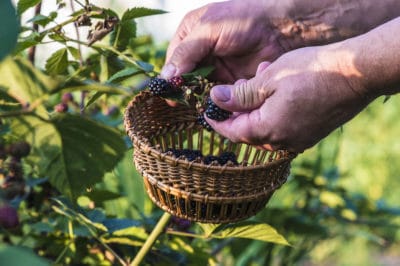Different Blackberries Ripen at Different Times
Different blackberry cultivars are classified as early-, mid- or late-season. Depending on which yours are — and where they’re growing in USDA plant hardiness zones 4 through 9 — they may begin ripening anywhere from early June to late August.
For an extended season of enjoyment, plant blackberries from all three categories:
- Early-season: ‘Arapaho,’ ‘Natchez,’ ‘Osage’ or ‘Prime-Ark Traveler.’
- Mid-season: ‘Cherokee,’ ‘Black Satin,’ or ‘Shawnee.’
- Late-season: ‘Chester,’ ‘Thomless Evergreen’ or ‘Hull Thornless.’
Primocane Blackberries
As perennials, blackberry plants live for several years. But their canes live for only two. First-year primocanes store the food they’ll need to produce flowers and fruit as second-year floricanes. At least, that’s how most blackberry plants operate.
On a few cultivars, however, floricane berries ripen in midsummer, followed by a smaller crop of primocane berries in late summer to early fall.
These primocane-fruiting cultivars include ‘Prime-Ark 45,’ ‘Prime-Ark Freedom,’ ‘Prime-Ark Traveler’ and ‘Stark Black Gem.’ Plant just one of them for a harvest of berries lasting from late June into September.
Signs Your Blackberries Are Ready to Pick
Completely ripe blackberries are plump and dull black. When lightly pressed, they feel just a bit tender. Grocery stores market glossy blackberries picked before ripening to protect them from shipping-related bruising.
Expert gardener’s tip: If you’ve never enjoyed a truly ripe, dull-black blackberry, the sweetness of your first be will be a real treat.
Picking your Blackberries
Blackberries won’t ripen off the bushes, but ripe ones hold their peak for just two or three days. On the other hand, berries on the same bush ripen at different rates. Miss a few ripe ones on the first pass and you’ll soon have replacements. Expect to be picking them every two days for up to a month.
Pick in the coolest part of the day, if possible when the bushes are dry. Protect yourself from thorny canes with long pants, a long-sleeved shirt and heavy-duty, forearm-length gloves. Grasp a gap in one of the fruiting canes, pull it toward you and gently twist a berry. If it resists, it’s not ripe.
Place the berries carefully in your collection container. To minimize bruising, don’t layer them too deeply. Keep the containers shaded while you work.
